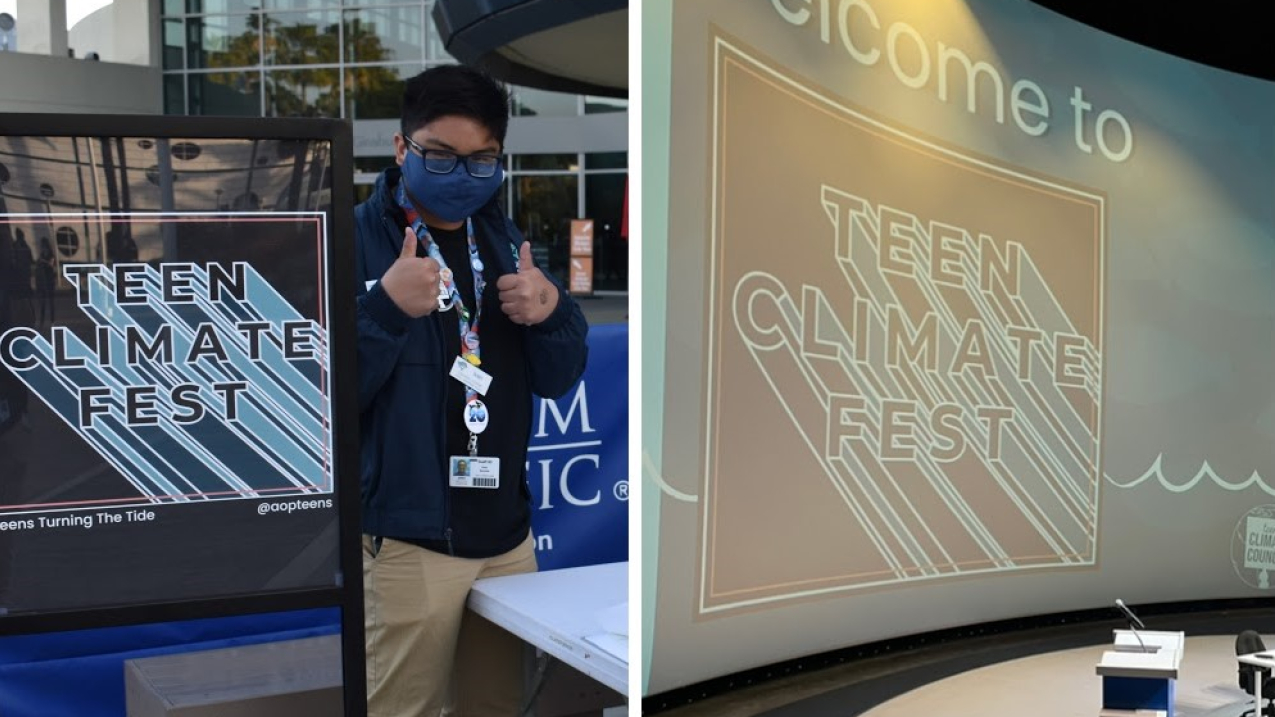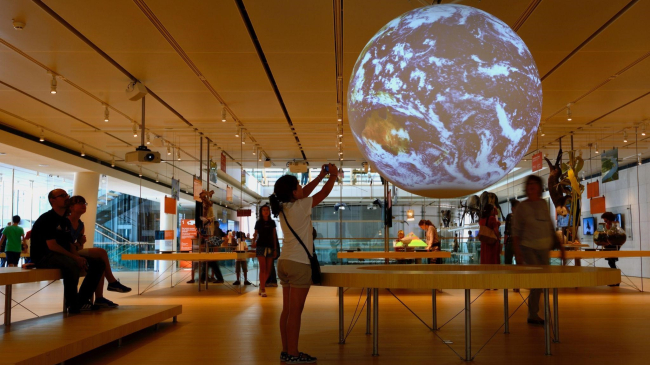As the largest aquarium in Southern California, Aquarium of the Pacific offsite link is dedicated to cultivating fascination and encouraging stewardship for the Pacific Ocean. This institution is one of 25 aquariums and marine science education centers across North America that make up the Coastal Ecosystem Learning Centers (CELC) network. Together this network engages the public in protecting coastal and marine ecosystems and work on shared priorities, including youth engagement.

(Left) Teen volunteer from the Aquarium of the Pacific poses next to a check-in table for the Teen Climate Fest. (Right) Stage set-up for the moderator and panelists who were scheduled to speak at the event. (Image credit: Aquarium of the Pacific)
The network worked with a team of high school aquarium volunteers to plan the 2021 CELC Virtual Youth Summit, which brought together more than 60 high school volunteers from CELC network aquariums to hear from speakers on how to make a difference for the ocean through art, writing, advocacy, and more.
A group of teen volunteers at the Aquarium called the Teen Climate Council offsite link attended the summit and received funding from NOAA and the North American Association for Environmental Education offsite link to take what they learned to design and lead an action project in their local community. The team chose to implement an event called Teen Climate Fest to raise awareness on climate change impacts and responses. We asked the teens to reflect on their project and what they learned through their experiences. Read what they shared below!
Tell us the story of your project.
For the Teen Climate Council’s project we hosted the Teen Climate Fest on May 1, 2022. The Teen Climate Fest has been a work in progress for the past three years, but was put on hold due to the COVID-19 pandemic. NOAA’s CELC Youth Summit gave us the perfect opportunity to restart our plans and bring them to fruition.
The Teen Climate Fest provided the opportunity for middle and high school students and attending families to learn from professionals and businesses about climate change and the implementation of sustainability into various fields of study. Through our event, we hoped to inspire teens to take further action against climate change and to pursue careers in sustainability. We hoped to normalize the discussion about sustainability and to introduce the teens attending our event to the multitude of ways society can begin talking about the world’s ever-changing environment. In all, the event was incredibly successful with 13 booths, a total of 198 RSVPs displaying community interest and engagement, and 108 attendees, not including booths and panelists. From the beginning of the festival, the room was buzzing with networking and communications between not only the guests, but the booths and panelists as well. At the end of the night, we encountered many guests asking about coming back next year and pathways to involvement.
The Teen Climate Fest consisted of a panel where the following five panelists discussed their careers in sustainability, including their inspirations, challenging and embarrassing experiences in their careers, and excitement for the future of sustainability: Dr. Peter Kareiva, CEO of the Aquarium of the Pacific; Emily Yam, Senior Manager of Education Aquarium of the Pacific; Kim Thompson, Director of Seafood for the Future; Raelene Child, Youth Program Director of Youth Leadership Long Beach; and Robin Aube, Director of Advancement AltaSea at the port of Long Beach.
Directly after the panelist discussion, we began the second portion of Teen Climate Fest: interacting with various booths that involved organizations, sponsors, scientists, and students demonstrating their research and mission in environmental science sustainability. All of our booths helped with the success of our event. The festival had a total of 13 booths each sharing unique topics of interest and fields of study focused on the awareness and relevance of climate change.
What went well in the project, and what did not go according to plan?
Throughout the event we could feel the room buzzing with people talking and interacting. Our space, the Pacific Visions Theater and Gallery, was an ideal location. Not too cramped and not too empty, the room allowed everyone to stay close and interact with one another. Additionally, the booths were close together so attendees could go straight from one to the next in order to see everything the event had to offer. Each booth was interactive and had something new to offer to our guests from activities to handouts to engaging posters. This allowed attendees to truly get a feel for the multitude of paths in the fields of sustainability, marine science, and environmental science. The atmosphere was also perfect for networking, a main goal of our event. Everyone was able to choose who they wanted to talk to and really pursue the themes and groups that were interesting to them.
In addition to the success surrounding the actual event, we were able to efficiently collaborate with departments across the Aquarium when planning the Teen Climate Fest. Through the InterOffice Memorandum and other tasks, we worked with the audio/video team in order to coordinate microphones, slides, and other technical aspects in the theater and gallery. We also worked with Guest Services for the event set up, final attendee counts, and coordination with Environmental Services. In addition we worked with Marketing, Development, Security, and more. Throughout the planning process we were able to successfully overcome every challenge with COVID-19 guidelines, space availability, booth and panelist needs, and more.
In the future there are a few things we would hope to change about the Teen Climate Fest. We felt that this year the event was too short and so we didn’t have enough time for everything we had originally hoped for. We want to be able to give attendees more time to look around the booths as well as the rest of the Aquarium. We also want to have a section of time for attendees to ask the panelists questions. We felt that the panelists had amazing answers for all of the questions we had written, and we found ourselves, and attendees, wanting to hear more.
We also felt that the check-in process could have been more streamlined, and in the future we want to develop a more efficient process for attendee entrance into the event. This could be done by using a more organized check-in list and letting or checking people into the event earlier with a waiting space. We also want to spend more time working through the space to make sure booths are evenly spaced and placed in a more inclusive configuration. We want to think more clearly through the order of booths and the guest experience as they walk through the event. We also, of course, hope to make the Teen Climate Fest bigger and better next year by increasing our attendee capacity and bringing in even more booths and panelists. We hope to take what we have learned in planning our first Teen Climate Fest and turn it into an annual event.
What impact did your project have?
The Teen Climate Council provides its members a community of passionate, like-minded students, which is something we can’t always find at school or in other aspects of our lives. The Teen Climate Fest did the same for many of our attendees that evening by providing them a space to network with leaders in fields of their interest and learn about topics that aren’t typically discussed in schools or at home. Our event was not only the introduction for many of our attendees, but also provided them with the resources they need to continue to pursue their passions, or to start getting involved in topics of their interest.
Whether they were a student, teacher, parent, or family member, the Teen Climate Fest provided a space for all of our attendees to explore the world of sustainability, gain resources that would allow them to get involved, and got them to just start talking with one another about where our planet is heading and how implementing even small actions of sustainability into our daily lives can have big impacts on the world’s ever-changing environment
How did the project impact you?
The entire planning process for the Teen Climate Fest was a learning experience. Few to none of us had ever planned an event so big, and so we were all excited to absorb anything we could about planning large events and working with an organization as big as the Aquarium of the Pacific in order to reach our goals. We learned about all of the little aspects involved with planning an event that hadn’t occurred to us before, both on our end when reaching out to booths, panelists, attendees, etc., but also on the Aquarium’s end to make sure they had everything they needed from us. While planning we learned about how all of the different departments in the Aquarium work together for projects of all sizes from our large event to the everyday guest experience. In addition to working with the rest of the Aquarium, we learned about the importance of communicating with each other. In order to help the event run smoothly we had to make sure we were working together and all on the same page so that we could provide a positive and engaging experience for all involved in our event. We can’t wait to take what we have learned and plan an even better event next year!



